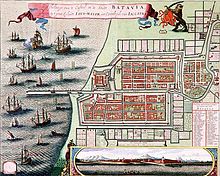Kota Tua, Jakarta
From Wikipedia, the free encyclopedia
Dubbed "The Jewel of Asia" and "Queen of the East" in the 16th century by European sailors, Old Jakarta — or Batavia, as it was named by the Dutch — was once a center of commerce for the whole continent due to its strategic location and abundant resources.
History
Main article: History of Jakarta
In
1526, Fatahillah, sent by Sultanate of Demak, invaded Hindu Pajajaran's
port of Sunda Kelapa, after which he renamed it into Jayakarta. This
town was only 15 hectare in size and had a typical Javanese harbour
lay-out. In 1619 the VOC destroyed Jayakarta under the command of Jan
Pieterszoon Coen. A year later the VOC built a new town named "Batavia"
to honor Batavieren, the Dutch ancestors. This city was centered around the east bank of the Ciliwung river, around present day Fatahillah Square.
Inhabitants
of Batavia are called "Batavianen", later known as "Betawi" people, the
creole ethnic, the descendants of mixed various ethnicities that
inhabited Batavia.
In 1635 the city expanded towards the west banks of Ciliwung, on the
ruins of former Jayakarta. The city was designed in European Dutch style
complete with a fortress (Kasteel Batavia), city wall, and canals. The
city was arranged in several blocks separated by canals.The
city of Batavia was completed in 1650. It became the headquarters of
the VOC in the East Indies.
The canals were filled up due to outbreaks of tropical diseases within
the city walls because of poor sanitation. The city began to expand
further south as epidemics in 1835 and 1870 forced more and more people
to move out of the cramped city, to the Weltevreden area (now the area
surrounding Merdeka Square). The city later became the administrative
center of the Dutch East Indies. In 1942 during the Japanese occupation,
Batavia was renamed Jakarta, and still serves as the capital city of
Indonesia.
In 1972, the Governor of Jakarta, Ali Sadikin,
issued a decree that officially made the Jakarta Kota area into a
heritage site. The governor's decision was necessary in order to
preserve the city's architectural roots — or at least what was left of
it.
Despite the Governor's Decree, the old town remains neglected. Even
though the majority was pleased just by the issuing of the decree, not
enough was being done to protect and conserve the legacy from the Dutch
colonial era.
Notable sites
- Luar Batang Mosque
- The Port of Sunda Kelapa
- Pasar Ikan (Fish Market)
- Maritime Museum and Menara Syahbandar
- Kota Intan Drawbridge
- Kali Besar (Grootegracht)
- Gereja Sion
- Wayang Museum
- Fine Art and Ceramic Museum (Former Court of Justice of Batavia)
- Jakarta History Museum (Former City Hall of Batavia)
- Cafe Batavia
- Toko Merah
- Chartered Bank
- Bank Indonesia Museum
- Bank Mandiri Museum
- Jakarta Kota Station (Beos Station)
- Glodok and Pinangsia Area (Jakarta Chinatown)
- Petak Sembilan
- Jin De Yuan Temple (Vihara Dharma Bhakti)
- Chandranaya Building
However, there is still much hope in restoring the area, especially with various non-profit organizations, private institutions, and even the government recently stepping up to the plate to rejuvenate Old Jakarta's legacy. In 2007, several streets surrounding Fatahillah square such as Pintu Besar street and Pos Kota street, were closed to vehicles as a first step towards the rejuvenation.







